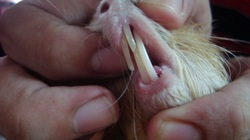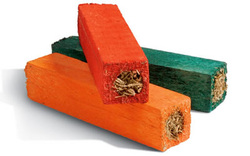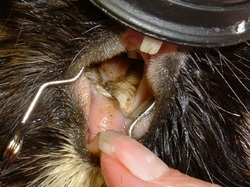Teeth
Guinea pigs, like all other rodents, have two incisors (front teeth) on the top and two incisors on the bottom of their mouth. They don’t have any canine teeth, so there’s a gap between their front teeth and back teeth.
Cavies do not chew. Instead, they gnaw and grind their food, and this wears down their teeth. To compensate for all that wear and tear, they have teeth that grow their whole lives. In order to keep them the right length, they must have things to gnaw on. I use small branches from my apple trees. There are some types of trees that are poisonous to guinea pigs, but I know that apple trees are safe. In fact, you can buy apple twigs and wood blocks at pet stores.
Guinea pigs can have life-threatening problems because of their teeth, so it’s important that you check them regularly. Make sure they are lined up properly, and make sure they are not getting too long. Teeth that are not lined up right are called “malocclusion”. At the very least, the guinea pig can have trouble eating, and at worst, the teeth can get so long that they cut into the opposite gums and create abscesses and infection!
Sometimes the teeth have to be removed, but a guinea pig that has a malocclusion will usually do fine if the teeth are just trimmed. They are trimmed with special scissors that will not crack them. The teeth are brittle, and in this case they are weaker than normal due to the malocclusion. They can easily fracture if they are not trimmed by a professional, so don’t try to do it at home.
Cavies can also get molar spurs if the teeth do not wear down properly. The sharp points cause damage to the cavy’s tongue or cheeks, so they have to be filed down.
If a tooth breaks off, it may be because the cavy fell, or because the guinea pig isn’t getting enough vitamins. See your vet right away if this happens.
Cavies can also get infections around their teeth and in their mouth.
If your cavy loses weight, doesn’t want to eat, or slobbers, it might have trouble with its teeth. Depending on the problem, the vet may be able to help by trimming the tooth, giving your cavy antibiotics, or filing the tooth.
Guinea pigs, like all other rodents, have two incisors (front teeth) on the top and two incisors on the bottom of their mouth. They don’t have any canine teeth, so there’s a gap between their front teeth and back teeth.
Cavies do not chew. Instead, they gnaw and grind their food, and this wears down their teeth. To compensate for all that wear and tear, they have teeth that grow their whole lives. In order to keep them the right length, they must have things to gnaw on. I use small branches from my apple trees. There are some types of trees that are poisonous to guinea pigs, but I know that apple trees are safe. In fact, you can buy apple twigs and wood blocks at pet stores.
Guinea pigs can have life-threatening problems because of their teeth, so it’s important that you check them regularly. Make sure they are lined up properly, and make sure they are not getting too long. Teeth that are not lined up right are called “malocclusion”. At the very least, the guinea pig can have trouble eating, and at worst, the teeth can get so long that they cut into the opposite gums and create abscesses and infection!
Sometimes the teeth have to be removed, but a guinea pig that has a malocclusion will usually do fine if the teeth are just trimmed. They are trimmed with special scissors that will not crack them. The teeth are brittle, and in this case they are weaker than normal due to the malocclusion. They can easily fracture if they are not trimmed by a professional, so don’t try to do it at home.
Cavies can also get molar spurs if the teeth do not wear down properly. The sharp points cause damage to the cavy’s tongue or cheeks, so they have to be filed down.
If a tooth breaks off, it may be because the cavy fell, or because the guinea pig isn’t getting enough vitamins. See your vet right away if this happens.
Cavies can also get infections around their teeth and in their mouth.
If your cavy loses weight, doesn’t want to eat, or slobbers, it might have trouble with its teeth. Depending on the problem, the vet may be able to help by trimming the tooth, giving your cavy antibiotics, or filing the tooth.



